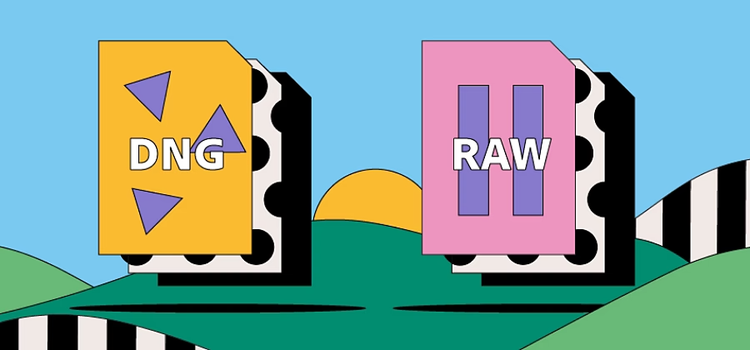PHOTOGRAPHY
DNG vs. RAW.
Digital cameras use RAW files for shooting and storing images. DNG files are for photo editing. Both produce incredibly vibrant images and are a big part of a professional photographer’s or editor’s toolbox. If you’re working with high-resolution images, let’s dive into whether you should use a DNG or RAW file type.

https://main--cc--adobecom.hlx.page/cc-shared/fragments/seo-articles/get-started-notification-blade
What is a DNG file?
DNG stands for Digital Negative Image. DNG is an open-source, royalty-free, highly compatible, and continuously improving raw image format that was built for editing photos — especially with Adobe software.
What is a RAW file?
RAW files are just that — raw, untouched, and unprocessed images recorded directly from a camera’s sensor. All available image data is there with no information cut or compressed. This leads to high-quality images that you can edit with minimal quality loss. Digital cameras, image scanners, and film scanners all produce RAW files.
What is the difference between DNG and RAW files?
There are several important differences between the two file types, especially in how to edit and store them.
DNGs are easier to edit.
Editing a RAW file can be a challenge. You’ll need to use a sidecar or convert them to other formats first. A sidecar is a separate XMP file that contains all edits, changes, and settings. Essentially, this creates a separate file so the original RAW file remains completely untouched and unchanged. Sidecars are small, but they also mean that every RAW file is effectively stored as two files.
With DNGs, edits and changes are written directly into the file. This leads to fewer files for storage, but also strips out information that you can’t recover later.
Quality and file size.
DNG files are generally 15-20% smaller than RAW files, but the difference in quality is minimal. A DNG file can also save the original RAW file within itself. This doubles the size, but is also a nice safeguard.
DNG files also strip out select information to decrease the size and simplify storage and editing. This may include JPEG previews, GPS information, metadata, and certain camera models’ focal points, lighting, and picture controls.
Memory and archives.
You can compress DNG files. This makes them much smaller than RAW files and ideal for storage and archives. Notably, the United States Library of Congress uses DNG files for this purpose. Another useful archival feature is that DNGs can self-check for corruption.
Compatibility.
You can’t edit RAW files with third-party software. Further complicating matters, there are many types of RAW files. They differ by camera manufacturer, and in some cases, by sensor models. A RAW file from a Canon will not be the same as one from a Nikon. This can be even more problematic if you have a brand-new, high-end camera. It can take time for the software to catch up with your model.
DNG files course-correct for the wide variety of RAW file types available. As a single, open-source, highly compatible format, DNGs help to ensure that you’ll always be able to open your photo files — even if your camera brand stops supporting its native RAW file type. On the other hand, DNG files may not always work with the software that camera manufacturers produce for their own photographs.
Editing.
The simplest way to edit RAW files is by converting them to DNG. Depending on your computer, software, and how many photos you have, this could take hours and sometimes even days — but it’s worth knowing that you’ll always be able to open and edit your DNG file.
DNG files work well with Adobe programs like Photoshop and {{lightroom}}. If you have many photos to edit, using DNGs can be a good idea thanks to built-in shortcuts and streamlined processes built into the files.
Working with other photo editors
RAW sidecars may sound complicated, but they’re an excellent solution if you work with other photo editors. Provided you have the original RAW file, you can send the sidecar back and forth to work together on an image.
When using DNG files in collaborations, you’ll need to share the entire file and ensure it’s the latest version. This may present challenges over time, especially if you have a large number of files.
DNG vs. RAW files: frequently asked questions.
Why do photographers shoot in RAW?
Should I shoot in RAW and save as DNG?
How do I open a RAW file?
To open a RAW file in Adobe Photoshop, follow these steps.
- Open Adobe Photoshop.
- Select File > Open.
- Select the file from your computer.
- Select Open.
